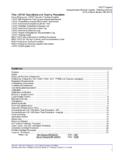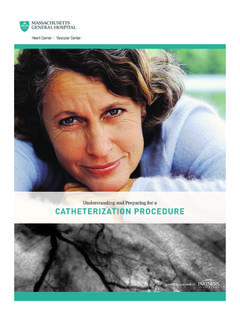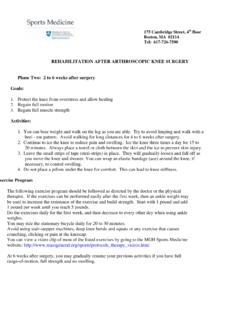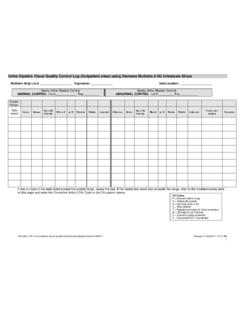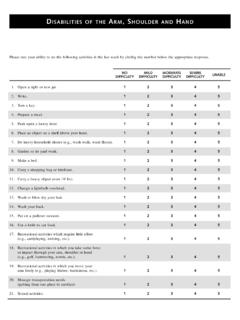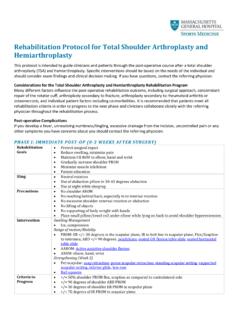Transcription of Rehabilitation Protocol for Reverse Shoulder Arthroplasty
1 Rehabilitation Protocol for Reverse Shoulder Arthroplasty This Protocol is intended to guide clinicians and patients through the post-operative course after a Reverse Shoulder Arthroplasty . Specific interventions should be based on the needs of the individual and should consider exam findings and clinical decision making. If you have questions, contact the referring physician. There are a few significant differences in post-operative guidelines between a total Shoulder Arthroplasty (TSA) and Reverse Shoulder Arthroplasty (RSA) primarily due to rotator cuff arthropathy. Deltoid function and periscapular strength become primary sources of Shoulder mobility and stability. Considerations for the Reverse Shoulder Arthroplasty Rehabilitation Program Many different factors influence the post-operative Reverse Shoulder Arthroplasty Rehabilitation outcome, including surgical approach, concomitant repair of the rotator cuff, Arthroplasty secondary to fracture, Arthroplasty secondary to rheumatoid arthritis or osteonecrosis, revision Arthroplasty , and individual patient factors including co-morbidities.
2 It is recommended that patients meet all Rehabilitation criteria in order to progress to the next phase and clinicians collaborate closely with the referring physician throughout the Rehabilitation process. Post-operative Complications If you develop a fever, unresolving numbness/tingling, excessive drainage from the incision, uncontrolled pain, unresolving tenderness over the acromion or any other symptoms you have concerns about you should contact the referring physician. PHAS E I : IM MEDI AT E POST-OP (2-3 W E EKS AF TE R S UR GER Y) Rehabilitation Goals Protect surgical repair Reduce swelling, minimize pain Maintain UE ROM in elbow, hand and wrist Gradually increase Shoulder PROM Minimize muscle inhibition Patient education Sling Neutral rotation Use of abduction pillow in 30-45 degrees abduction Use at night while sleeping Precautions No Shoulder AROM No Shoulder AAROM No Shoulder PROM in to IR No reaching behind back, especially in to internal rotation No lifting of objects No supporting of body weight with hands Place small pillow/towel roll under elbow while lying on back to avoid Shoulder hyperextension Intervention Swelling Management Ice, compression Range of motion/Mobility PROM.
3 ER in the scapular plane to tolerance, Flex/Scaption </= 120 degrees, ABD </= 90 degrees, seated GH flexion table slide, pendulums, seated horizontal table slides AAROM: none AROM: elbow, hand, wrist Criteria to Progress Gradual increase in Shoulder PROM 0 degrees Shoulder PROM in to IR Pain < 4/10 No complications with Phase I M as sa c h u se tt s G en era l H o spi ta l S po rts M e di ci ne 2 PHAS E I I: IN TER ME DIATE POS T-OP (4-6 WEE KS AF TE R S UR GERY) Rehabilitation Goals Continue to protect surgical repair Reduce swelling, minimize pain Gradually increase Shoulder PROM Initiate Shoulder AAROM/AROM Initiate periscapular muscle activation Initiate deltoid activation (avoid Shoulder extension when activating posterior deltoid)
4 Patient education Sling Use at night while sleeping Gradually start weaning sling over the next two weeks during the day Precautions No reaching behind back, especially in to internal rotation No lifting of objects heavier than a coffee cup No supporting of body weight with hands Place small pillow/towel roll under elbow while lying on back to avoid Shoulder hyperextension Intervention *Continue with Phase I interventions Range of motion/Mobility AAROM: Active assistive Shoulder flexion, Shoulder flexion with cane, cane external rotation stretch, washcloth press, seated Shoulder elevation with cane AROM: supine flexion, salutes, supine punch Strengthening Periscapular: scap retraction, standing scapular setting, supported scapular setting, low row, inferior glide Deltoid: isometrics in the scapular plane Criteria to Progress Gradual increase in Shoulder PROM, AAROM, AROM 0 degrees Shoulder PROM in to IR Palpable muscle contraction felt in scapular musculature Pain < 4/10 No complications with Phase II PHAS E I II.
5 I NTE RME DIATE POS T-OP CON TD (7-8 W EE KS AFT ER S URGE RY) Rehabilitation Goals Minimize pain Gradually progress Shoulder PROM, initiate Shoulder PROM IR in the scapular plane Gradually progress Shoulder AAROM Gradually progress Shoulder AROM Progress deltoid strengthening Progress periscapular strengthening Initiate motor control exercise Patient education Sling Discontinue Precautions No reaching behind back beyond pant pocket No lifting of objects heavier than a coffee cup No supporting of body weight with hands Avoid Shoulder hyperextension Intervention *Continue with Phase I-II interventions Range of motion/Mobility PROM: Full in all planes, gradual PROM IR in scapular plane </=50 degrees AAROM: incline table slides, wall climbs, pulleys, seated Shoulder elevation with cane with active lowering AROM: seated scaption, seated flexion, supine forward elevation with elastic resistance to 90 deg Strengthening Periscapular: Row on physioball, serratus punches Deltoid.
6 Seated Shoulder elevation with cane, seated Shoulder elevation with cane with active lowering, ball roll on wall Motor control IR/ER in scaption plane and Flex 90-125 (rhythmic stabilization) in supine Stretching Sidelying horizontal ADD, triceps and lats M as sa c h u se tt s G en era l H o spi ta l S po rts M e di ci ne 3 Criteria to Progress ROM goals**: o Elevation </= 140 degrees o ER </= 30 degrees in neutral o IR </= 50 degrees in scapular plane or back pocket o **PROM and AROM expectations are individualized and dependent upon ROM measurements attained in the OR post-operatively Minimal to no substitution patterns with Shoulder AROM Pain < 4/10 PHAS E IV : T RANS ITI ONAL POST-OP (9-1 1 WE E KS AFT ER SURGERY) Rehabilitation Goals Maintain pain-free ROM Progress periscapular strengthening Progress deltoid strengthening Progress motor control exercise Improve dynamic Shoulder stability Gradually restore Shoulder strength and endurance Return to full functional activities Precautions No lifting of heavy objects (> 10 lbs) Intervention *Continue with Phase II-III interventions Range of motion/mobility PROM: Full ROM in all planes Strengthening Periscapular: Resistance band Shoulder extension, resistance band seated rows, rowing, robbery, lawnmowers, tripod, pointer Deltoid.
7 Gradually add resistance with deltoid exercise Motor control IR/ER and Flex 90-125 (rhythmic stabilization) Quadruped alternating isometrics and ball stabilization on wall Field goals PNF D1 diagonal lifts, PNF D2 diagonal lifts Criteria to Progress Performs all exercises demonstrating symmetric scapular mechanics Pain < 2/10 PHAS E V: ADV AN CE D ST RE NGT HEN ING POST-OP (12-1 6 WE EKS AF TE R S UR GER Y) Rehabilitation Goals Maintain pain-free ROM Initiate RTC strengthening with a concomitant repair Improve Shoulder strength and endurance Enhance functional use of upper extremity Precautions No lifting of objects (> 15 lbs) Intervention *Continue with Phase II-IV interventions Strengthening Periscapular: Push-up plus on knees, W exercise, resistance band Ws, prone Shoulder extension Is, dynamic hug, resistance band dynamic hug, resistance band forward punch, forward punch, T and Y, T exercise Deltoid: continue gradually increasing resisted flexion and scaption in functional positions Elbow.
8 Bicep curl, resistance band bicep curls, and triceps Rotator cuff: internal external rotation isometrics, side-lying external rotation, Standing external rotation w/ resistance band, standing internal rotation w/ resistance band, internal rotation, external rotation, sidelying ABD standing ABD Motor Control Resistance band PNF pattern, PNF D1 diagonal lifts w/ resistance, diagonal-up, diagonal-down, wall slides w/ resistance band Criteria to Progress Clearance from MD and ALL milestone criteria have been met Maintains pain-free PROM and AROM Performs all exercises demonstrating symmetric scapular mechanics QuickDASH PENN M as sa c h u se tt s G en era l H o spi ta l S po rts M e di ci ne 4 Revised December 2018 Contact Please email with questions specific to this Protocol References Angst F, Goldhahn J, et al.
9 Responsiveness of six outcome assessment instruments in total Shoulder Arthroplasty . Arthritis & Rheumatism. 2008. 59 (3): 391-398. Boudreau S, Boudreau E. Higgins LD, Wilcox III Rehabilitation following Reverse total Shoulder Arthroplasty . JOSPT. 2007. 37 (12): 734-744. Garcia GH, Taylor SA, et al. Patient activity level after Reverse total Shoulder Arthroplasty : what are patients doing? Am J of Sports Med. 2015. 43 (11): 2816-2821. Gaunt BW, McCluskey GM, Uhl TL. An electromyographic evaluation of subdividing active-assistive Shoulder elevation exercises. Sports Health. 2010. 2 (5): 424-432. Hughes M, Neer II CS. Glenohumeral joint replacement and postoperative Rehabilitation . Physical Therapy. 1975. 55(8): 850-858.
10 Kibler WB, Sciascia, AD, Uhl, TL, et al. Electromyographic analysis of specific exercises for scapular control in early phases of Shoulder Rehabilitation . The American Journal of Sports Medicine. 2008. 36(9): p. 1789-1798. Knesek M, Brunfeldt A, et al. Patterns of strain and the determination of the safe arc of motion after subscapularis repair-a biomechanical study. Journal of Orthopaedic Research. 2016. 34: 518-524. Piasecki DP, Nicholson GP. Tears of the subscapularis tendon in athletes-diagnosis and repair techniques. Clin Sports Med. 2008. 27: 731-745. Uhl TL, Muir TA, et al. Electromyographical assessment of passive, active assistive, and active Shoulder Rehabilitation exercises. PM R. 2010. 2: 132-141.


